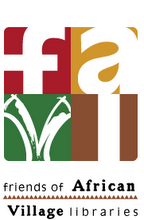Although Raeez Writes is the only book (selected from the original 2002 set of books) that uses photographs, it was chosen because the committee felt that the topic of illuminating how we can support reading and writing habits was significant and because the characters would be familiar enough with children from the different regions of Africa. The story provides an example of how a young child, Raeez, apprentices himself to his grandfather, who helps him to write. When Raeez is asked where he is going, the reader is told “Raeez knows where he is going.” He is then depicted sitting at a table with Grandpa who is holding a newspaper: “Grandpa wants to read. Raeez wants to write.” We then see Grandpa stand up and help Raeez: “Grandpa helps Raeez.” “Then Grandpa reads and Raeez writes.” The final page has emergent writing around a drawing, and Raeez’s words, “Look what I wrote!”—celebrating and valuing the young child’s immature explorations in writing.
In dealing with names in the different language versions of the books, it was decided that as a rule, we should keep the name of the original, existing characters. For example, Ali and Titilope would remain such—as it is in life, people usually only change their names for cultural reasons or if they are oppressed in some way. At the same time, there are differing views on this and once the stories went for translation, they sometimes took on a life of their own, with one or another translator expressing adamantly that a name needed a spelling adaptation. For example in Orange, the original name “Beruk” became “Beruki” and “Mimi” became “Mimii” in Kiswahili. In Raeez Writes, it was decided that the name Raeez would be impossible to pronounce in Portuguese and so he became Rafique.
Nice and Clean, written in Ethiopia, is about personal hygiene. The first draft of the story was reminiscent of a lifeskills lesson, probably due in part to the challenge of translating from Amharic into English as well as the new challenge of writing for very young children. In the edited English version lightness and humor were introduced into the text through the use of repetition and wordplay. We also discussed where to best situate the story, and who the characters should be. What kind of technology should illustrate cleaning? Were baths, showers, and taps attached to sinks and basins appropriate? Could we illustrate brushing teeth with a toothbrush? None of these would be familiar practices for all children.
The challenge of where to situate a story and what characters to use was resolved in this case by a decision to use a simple outside rural environment, with a basic building that allowed for inside scenes. The characters are animals common to many African settings instead of human beings thus allowing children anywhere to identify with their actions. A mixture of scenarios were chosen and used—washing outside using a tap and bucket as well as indoors with all the modern features. On the first page we read, “Everybody needs to wash” and the story ends, “Now everybody’s nice and clean,” helping to pass on the message to young children, wherever they may be, that one of the things we share is a need to keep clean.
Read the full article here...
Saturday, July 18, 2009
Nice article about experience in publishing children's books
By Carole Bloch
Subscribe to:
Post Comments (Atom)

No comments:
Post a Comment